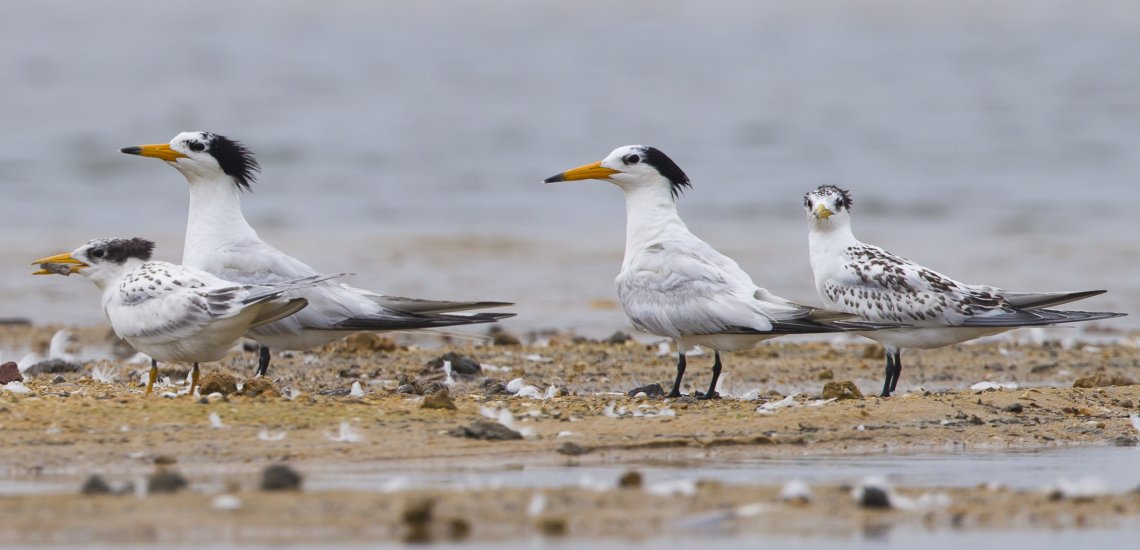6 January 2017
Shaun Hurrell, BirdLife International – Asia
Asia’s rarest seabird has been discovered breeding in the Korean Peninsula. This new stronghold could help the Chinese Crested Tern bounce back from near-extinction.
“Our hearts raced as we saw them,” recalls Yunkyoung Lee and Se-Kyu Song. Amongst the hustle and bustle of a Black-tailed Gull Larus crassirostris breeding colony, the scene was a squawking mass of grey-and-white feathers and black-tipped bills. But in the chaos something looked different. If their eyes were not deceiving them, the researchers were looking at a bird never before seen in South Korea. They focused harder, knowing that less than 100 individuals of this species are known to exist in the world…
As part of a routine survey undertaken by the National Institute of Ecology of Korea, the team were on a rocky islet in the Yellow Sea, seven kilometres off the coast of southwestern South Korea. It was there, amongst the sparse short grass, that they spotted an anomaly happily sitting amongst the gulls in the Spring of 2016. “When we saw the distinctive headcrests we couldn’t believe we were looking at two pairs of nesting Chinese Crested Tern”, said Yunkyoung.
Chinese Crested Tern Thalasseus bernsteini is one of the rarest birds in the world – possibly the rarest seabird in the world, and certainly in Asia. Only rediscovered 16 years ago on the east coast of mainland China, after its assumed extinction since 1937, only three breeding sites were known of this Critically Endangered tern, all on islands south of China. That is, until this year: as well as a new site confirmed in the Taiwanese Strait, one chick has fledged from another, a South Korean colony all the way across the Yellow Sea.

Chinese Crested Tern with a chick, and incubating, amidst Black-tailed Gull colony, South Korea © Yunkyoung Lee
“The return of Chinese Crested Tern as a breeding bird in the Yellow Sea is an extremely nice surprise,” says Simba Chan, Senior Conservation Officer for Asia, BirdLife International. Yet there is another twist in the tale: the situation in which the South Korean birds were found, breeding amongst a gull colony, gives new hope for the rare terns. At other discovered breeding sites (Matsu Islands, Jiushan Islands, Wuzhishan Islands and the recently-confirmed Penghu Islands), Chinese Crested Tern are found breeding in mixed colonies of Greater Crested Tern Thalasseus bergii. Chan explains the importance of the new discovery amidst the gulls: “There are no breeding colonies of Greater Crested Tern north of the Yangtze estuary, so we previously thought that Chinese Crested Tern would not breed in the Yellow Sea region before their numbers reached a threshold large enough to form their own colony. The new site means the future of this species looks more promising now, as there are more colonies where it can nest.”
But there are still many questions to answer before its future is safe, says Mike Crosby, Senior Conservation Officer, BirdLife International: “Given this potentially larger range, we need to understand why the species is so rare – could it be caused by egg collecting and human disturbance at the nesting colonies?”
Rapid response
Realising the importance of their discovery, the Korean researchers quickly sprung to action to protect the terns. “We immediately requested the Ministry of Environment to restrict all civilian access (even researchers), and to secure the area until breeding success was confirmed,” said Yunkyoung. “The Ministry also took action to help the birds.” By proposing conservation regulations and information on breeding behaviour, BirdLife is now supporting the Ministry to turn this designated Special Island for Protection into a stable breeding ground for the Chinese Crested Tern.
BirdLife restored the Jiushan Islands breeding colony, using decoy birds to attract Chinese Crested Tern, and hope to use this successful method again in South Korea. In 2014 and 2015, thirty chicks fledged from the Jiushan Islands site, carefully watched over by a dedicated BirdLife team. But this year, the fragile colony unfortunately failed to produce chicks, meaning the species is far from safe, and new breeding sites need to be secured

Based on Threatened Birds of Asia: The BirdLife International Red Data Book
Discovery in DPR Korea?
Inspired by the new discovery in South Korea, Simba Chan delved back into the history books in search of answers. “After careful study of an old record of a crested tern collected in 1917 from an island situated in present-day DPR Korea, I can deduce that the specimen was no doubt a Chinese Crested Tern.” So perhaps the latest discovery by the South Korean researchers is not the first time Chinese Crested Tern has been found breeding on the Korean Peninsula. In fact, further evidence suggests that there is indeed another, unknown, breeding site somewhere else in this region; in late August 2016 four Chinese Crested Terns (two adult and two fledglings) appeared in Qingdao, Shandong, northern China. As there was only one fledgling from the newly discovered South Korean colony, and this is far south of Qingdao, it suggests that the Yellow Sea could be much more important for this Critically Endangered species than previously thought.
The BirdLife International Chinese Crested Tern project is generously funded by the Ocean Park Conservation Foundation, Hong Kong; the Tilia Fund; and the BirdLife Preventing Extinctions Programme. Special thanks to Spike Millington and Nial Moores for pointing in the direction of possible Chinese Crested Tern records near Inchon, and to Miyako Tsurumi from the Yamashina Institute for Ornithology for providing advice and copy of the old record, which was written by Dr Nagamichi Kuroda.
Original article: http://www.birdlife.org/asia/news/tern-better
For more information on Chinese Crested Tern, visit the EAAFP Seabird Working Group page.






